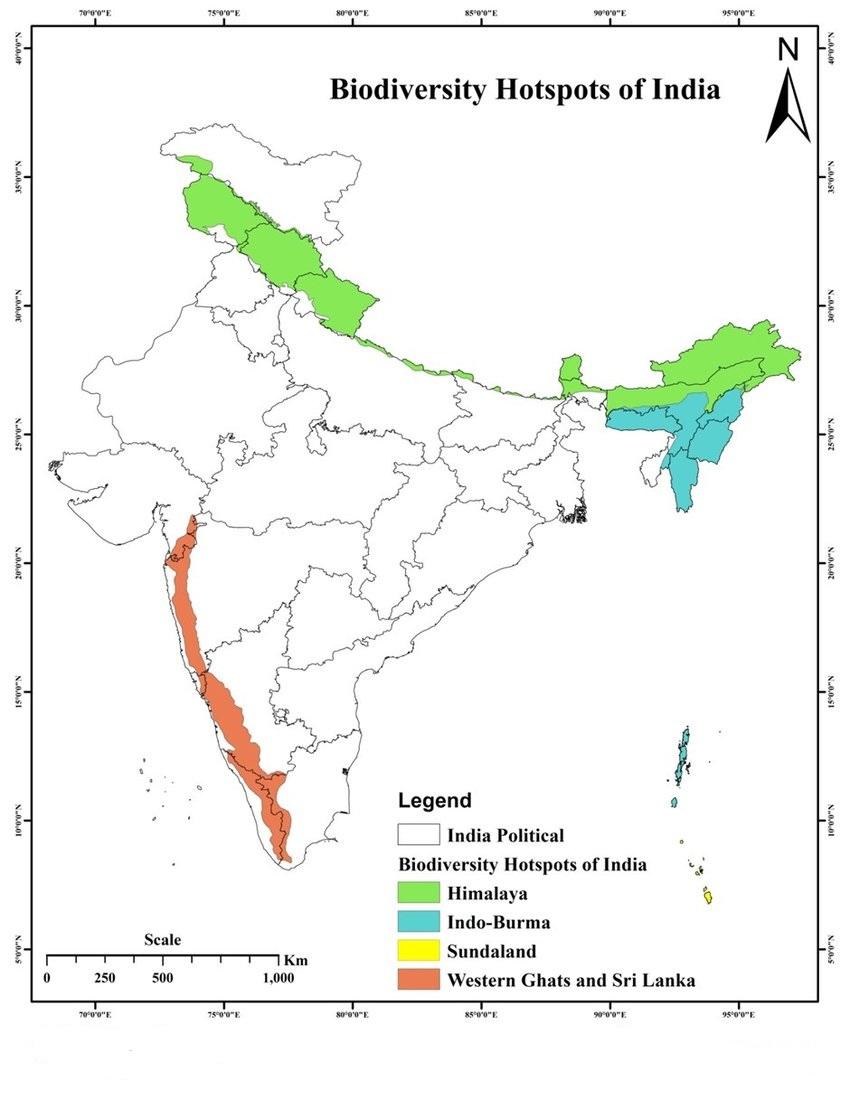Table of Contents
Biodiversity Hotspots in India
The variety of plant and animal species in a specific habitat is referred to as biodiversity. The two main elements of biodiversity are species evenness and species richness.
Around 24.46% of India’s total land area is covered by forests and trees, contributing to the country’s reputation for having a rich biodiversity.
The phrase “biodiversity hotspots,” coined by Norman Myers, refers to areas renowned for their high levels of species richness and endemism.
Biodiversity Hotspots in India 2 Main Qualifying Criteria
A region must meet both of the following requirements, according to Conservation International, in order to be considered a hotspot:
- The area should feature a high level of endemism and at least 1500 different species of vascular plants.
- It must be in danger and still have at least 30% of its original habitat.
Biodiversity Hotspots in India
There are four main biodiversity hotspots in India that meet the requirements for being designated as such:
- The Himalayas
- Indo-Burma Region
- The Western Ghats
- Sundaland
Biodiversity Hotspots in India- The Himalayas
The Himalayas, which are regarded as the highest mountains in the world, are located in North-East India, Bhutan, and the central and eastern regions of Nepal. 163 endangered species, including the one-horned rhino and wild Asian water buffalo, have been recorded in this region (NE Himalayas), along with 10,000 plant species, 3160 of which are indigenous. The size of this mountain range is around 750,000 km2.
Biodiversity Hotspots in India- Indo – Burma Region
The Indo-Burma Region spans a surface area of 2,373,000 km2. Six new species of large mammals have been found in this area over the past 12 years: the Large-antlered Muntjac, Annamite Muntjac, Grey-shanked Douc, Annamite Striped Rabbit, Leaf Deer, and Saola.
The indigenous freshwater turtle species found in this hotspot are also well-known, however the majority of them are endangered due to overfishing and severe habitat loss. The threatened White-eared Night-heron, Grey-crowned Crocias, and Orange-necked Partridge are just a few of the 1,300 diverse bird species that exist.
Biodiversity Hotspots in India- The Western Ghats
The majority of the deciduous woods and rain forests are covered by the Western Ghats, which are situated along the western edge of peninsular India. It is home to at least 325 species of fish, amphibians, birds, and reptiles that are considered to be globally threatened, according to UNESCO. Originally covering 190,000 km2, the vegetation in this area today only covers 43,000 km2. The region is also well-known for its 229 plant species, 31 animal species, 15 bird species, 43 amphibian species, 5 reptile species, and 1 fish species, all of which are considered to be globally threatened. According to UNESCO, of the 325 species that are globally threatened, 129 are designated as Vulnerable, 145 as Endangered, and 51 as Critically Endangered.
Biodiversity Hotspots in India- Sundaland
South-East Asia’s Sundaland hotspot includes Singapore, Thailand, Indonesia, Brunei, and Malaysia. The United Nations designated Sundaland as a World Biosphere Reserve in 2013. Famous for having a diverse terrestrial and marine environment, this area. One of the biologically richest regions in the world, Sundaland, contains 25,000 species of vascular plants, 15,000 of which are unique to this area.
Biodiversity Hotspots in India – Flora, and Fauna
The diverse flora and wildlife of India are well known. India is home to around 500 different mammal species, 200 different bird species, and 30,000 different insect species. The task of surveying India’s flora resources is within the purview of the Kolkata-based Zoological Survey of India.
India is reputed to contain the world’s richest flora, with over 18000 kinds of blooming plants, due to its unique climate, topology, and habitat. These plant species make up 6-7% of all plant species in the world. The Western and Eastern Himalayas, the Indus and Ganges, Assam, the Deccan, Malabar, and the Andaman Islands, which are home to 3000 Indian plant species, are the eight important floristic zones in India.
The forests in India cover ranges from the tropical rainforest including Andaman, Western Ghats, and northeast India to the coniferous forests of the Himalayas. The deciduous forests can be found in the eastern, central, and southern parts of India.
Biodiversity Hotspots in India- Endangered Species
The International Union for Conservation of Nature states that India is home to around 45,000 plant species and 91,000 animal species, accounting for 7-8% of all species that have been identified. But many species are extinction-threatened or in danger of going extinct due to the fast loss of biodiversity. Endangered species are those that are in danger of going extinct because of a sharp decline in their population and habitat.
| Top 5 Endangered Species of India | |
| Endangered Animal Species | Endangered Plant Species |
| The Royal Bengal Tiger | Ebony tree |
| The Great Asiatic Lion | Indian Mallow |
| The Snow Leopard | Malabar Lily |
| Nilgiri Tahr | Assam Catkin Yew |
| Indian Rhino | Milkwort |
Biodiversity Hotspots in India- What is the IUCN Red List?
The IUCN Red List, also known as the Red Data List and founded in 1964, assesses the biological species in the world that are threatened with extinction. IUCN wants to concentrate on species conservation to prevent extinction of species. On the IUCN Red List, more than 77,300 species have been evaluated.
The IUCN Red List can be divided into the following 9 categories:
- Extinct (EX) – No known individuals remaining.
- Extinct in the wild (EW) – Known only to survive in captivity, or as a naturalized population outside its historic range.
- Critically endangered (CR) – Extremely high risk of extinction in the wild.
- Endangered (EN) – High risk of extinction in the wild.
- Vulnerable (VU) – High risk of endangerment in the wild.
- Near threatened (NT) – Likely to become endangered shortly.
- Least concern (LC) – Lowest risk. Does not qualify for a more at-risk category. Widespread and abundant taxa are included in this category.
- Data deficient (DD) – Not enough data to assess its risk of extinction.
- Not evaluated (NE) – Has not yet been evaluated against the criteria
Biodiversity Hotspots in India- Tiger Conservation
The conservation of tigers has become vital in India as a significant portion of the country’s tiger population gets added to the list of endangered species. The “Project Tiger” project is one of the steps the Indian government has made to safeguard tigers. The National Tiger Conservation Authority oversaw this initiative, which was started in April 1973.
With Project Tiger, India’s tiger population will be safeguarded from extinction risk and biologically significant places would be preserved as a natural heritage.
The list of major threats to Tiger Population are:
- Man-animal conflict
- Hunting, poaching and illegal trade
- Habitat and loss of prey species
It is due to this initiative that India’s tiger population has risen to 2,967 in 2018 within 12 years. As per the latest data, the largest survey conducted by the government to map the Tiger Population in India till date was over 381,400 km of forested habitats across 20 states.



 Bihar Board 12th Result 2025 Out @ inter...
Bihar Board 12th Result 2025 Out @ inter...
 How Many Chapters are there in NEET Syll...
How Many Chapters are there in NEET Syll...
 CBSE Class 12 Computer Science Question ...
CBSE Class 12 Computer Science Question ...










